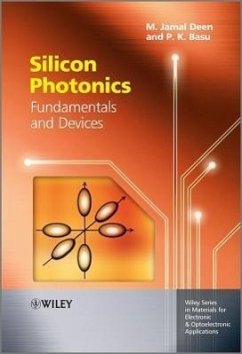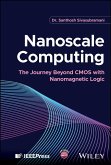- Gebundenes Buch
- Merkliste
- Auf die Merkliste
- Bewerten Bewerten
- Teilen
- Produkt teilen
- Produkterinnerung
- Produkterinnerung
The creation of affordable high speed optical communications using standard semiconductor manufacturing technology is a principal aim of silicon photonics research. This would involve replacing copper connections with optical fibres or waveguides, and electrons with photons. With applications such as telecommunications and information processing, light detection, spectroscopy, holography and robotics, silicon photonics has the potential to revolutionise electronic-only systems. Providing an overview of the physics, technology and device operation of photonic devices using exclusively silicon…mehr
Andere Kunden interessierten sich auch für
![Materials for Solid State Lighting and Displays Materials for Solid State Lighting and Displays]() Materials for Solid State Lighting and Displays193,99 €
Materials for Solid State Lighting and Displays193,99 €![Nanoscale Computing Nanoscale Computing]() Santhosh SivasubramaniNanoscale Computing147,99 €
Santhosh SivasubramaniNanoscale Computing147,99 €![Food Security in the Developing World Food Security in the Developing World]() Food Security in the Developing World168,99 €
Food Security in the Developing World168,99 €![Unmanned Aircraft Systems Unmanned Aircraft Systems]() Unmanned Aircraft Systems234,99 €
Unmanned Aircraft Systems234,99 €![Plant Breeding Reviews, Volume 9 Plant Breeding Reviews, Volume 9]() Plant Breeding Reviews, Volume 9420,99 €
Plant Breeding Reviews, Volume 9420,99 €![An Introduction to Water Quality Modelling An Introduction to Water Quality Modelling]() An Introduction to Water Quality Modelling376,99 €
An Introduction to Water Quality Modelling376,99 €![Hydrogeochemistry Fundamentals and Advances, Mass Transfer and Mass Transport Hydrogeochemistry Fundamentals and Advances, Mass Transfer and Mass Transport]() Viatcheslav V TikhomirovHydrogeochemistry Fundamentals and Advances, Mass Transfer and Mass Transport256,99 €
Viatcheslav V TikhomirovHydrogeochemistry Fundamentals and Advances, Mass Transfer and Mass Transport256,99 €-
-
-
The creation of affordable high speed optical communications using standard semiconductor manufacturing technology is a principal aim of silicon photonics research. This would involve replacing copper connections with optical fibres or waveguides, and electrons with photons. With applications such as telecommunications and information processing, light detection, spectroscopy, holography and robotics, silicon photonics has the potential to revolutionise electronic-only systems. Providing an overview of the physics, technology and device operation of photonic devices using exclusively silicon and related alloys, the book includes: * Basic Properties of Silicon * Quantum Wells, Wires, Dots and Superlattices * Absorption Processes in Semiconductors * Light Emitters in Silicon * Photodetectors, Photodiodes and Phototransistors * Raman Lasers including Raman Scattering * Guided Lightwaves * Planar Waveguide Devices * Fabrication Techniques and Material Systems Silicon Photonics: Fundamentals and Devices outlines the basic principles of operation of devices, the structures of the devices, and offers an insight into state-of-the-art and future developments.
Hinweis: Dieser Artikel kann nur an eine deutsche Lieferadresse ausgeliefert werden.
Hinweis: Dieser Artikel kann nur an eine deutsche Lieferadresse ausgeliefert werden.
Produktdetails
- Produktdetails
- Verlag: Wiley
- Seitenzahl: 454
- Erscheinungstermin: 30. April 2012
- Englisch
- Abmessung: 249mm x 173mm x 25mm
- Gewicht: 839g
- ISBN-13: 9780470517505
- ISBN-10: 0470517506
- Artikelnr.: 35054882
- Herstellerkennzeichnung
- Libri GmbH
- Europaallee 1
- 36244 Bad Hersfeld
- gpsr@libri.de
- Verlag: Wiley
- Seitenzahl: 454
- Erscheinungstermin: 30. April 2012
- Englisch
- Abmessung: 249mm x 173mm x 25mm
- Gewicht: 839g
- ISBN-13: 9780470517505
- ISBN-10: 0470517506
- Artikelnr.: 35054882
- Herstellerkennzeichnung
- Libri GmbH
- Europaallee 1
- 36244 Bad Hersfeld
- gpsr@libri.de
M. Jamal Deen completed a BSc degree at the University of Guyana (Guyana) and a PhD in Electrical Engineering and Applied Physics at Case Western Reserve University (USA). Professor Deen has been an assistant professor at Lehigh University, Bethlehem (USA) and was professor in the School of Engineering Science, Simon Fraser University, Vancouver (Canada). In 1999, he assumed his current position as Professor of Electrical and Computer Engineering, McMaster University, Hamilton (Canada). His current research interests include physics, modeling, reliability and parameter extraction of semiconductor devices; optical detectors and receivers, polymers and organic semiconductor devices, and low power, low-noise, high-frequency circuits. He is a Distinguished Lecturer of the IEEE- Electron Device Society, was awarded the 2002 Thomas D. Callinan Award from the Electrochemical Society, the Distinguished Researcher award, Province of Ontario and a Humboldt Research Award from the Alexander von Humboldt Foundation in 2006. In September 2008, he was awarded the prestigious Thomas W. Eadie medal by the Royal Society of Canada for his work on the modeling and noise of electronic and optoelectronic devices, with particular reference to silicon transistors and high-speed photodetectors. Prasanta Kumar Basu obtained his BSc and his PhD from the University of Calcutta (India). He worked in the Institute of Radio Physics and Electronics, as a lecturer, then as a reader and finally as a professor. He served as the Head of the Department and he is now the Programme Coordinator of the Centre of Advanced Study in Radio Physics and Electronics at the University of Calcutta. Professor Basu worked as a Postdoctoral Fellow at the Catholic University, Leuven, Belgium, as an Alexander von Humboldt Fellow in Wuerzburg University, Germany and has been a visiting professor at McMaster University, Hamilton, Canada several times. Professor Basu's research interests include semiconductor physics and devices, optoelectronics and optical communication, nanoelectronics and nanophotonics. He has more than 100 research publications in refereed journals and has authored a book Theory of Optical Processes in Semiconductors: Bulk and Microstructures.
Series Preface xv
Preface xvii
1 Introduction to Silicon Photonics 1
1.1 Introduction 1
1.2 VLSI: Past, Present, and Future Roadmap 2
1.3 The Interconnect Problem in VLSI 3
1.4 The Long-Haul Optical Communication Link 4
1.5 Data Network 7
1.6 Conclusions 7
1.7 Scope of the Book 8
2 Basic Properties of Silicon 11
2.1 Introduction 11
2.2 Band Structure 12
2.3 Density-of-States Function 17
2.4 Impurities 19
2.5 Alloys of Silicon and Other Group IV Elements 21
2.6 Heterojunctions and Band Lineup 23
2.7 Si-Based Heterostructures 24
2.8 Direct GAP: Ge/SiGeSn Heterojunctions 33
3 Quantum Structures 41
3.1 Introduction 41
3.2 Quantum Wells 41
3.3 Quantum Wires and Dots 48
3.4 Superlattices 50
3.5 Si-Based Quantum Structures 52
3.6 Effect of Electric Field 56
4 Optical Processes 61
4.1 Introduction 61
4.2 Optical Constants 61
4.3 Basic Concepts 64
4.4 Absorption Processes in Semiconductors 66
4.5 Fundamental Absorption in Direct GAP 66
4.6 Fundamental Absorption in Indirect GAP 73
4.7 Absorption and Gain 77
4.8 Intervalence Band Absorption 79
4.9 Free-carrier Absorption 80
4.10 Recombination and Luminescence 82
4.11 Nonradiative Recombination 86
4.12 Excitonic and Impurity Absorption 91
5 Optical Processes in Quantum Structures 97
5.1 Introduction 97
5.2 Optical Processes in QWs 98
5.3 Intersubband Transitions 105
5.4 Excitonic Processes in QWs 109
5.5 Effect of Electric Fields 114
5.6 Optical Processes in QWRs 118
5.7 Optical Processes in QDS 119
6 Light Emitters in Si 123
6.1 Introduction 123
6.2 Basic Theory of Light Emission 124
6.3 Early Efforts: Zone Folding 125
6.4 Band Structure Engineering Using Alloys 126
6.5 Quantum Confinement 129
6.6 Imputities in Silicon 134
6.7 Stimulated Emission: Prospect 139
6.8 Intersubband Emission 143
6.9 Tensile-Strained Ge Layers 146
7 Si Light Modulators 151
7.1 Introduction 151
7.2 Physical Effects 152
7.3 Electrorefraction in Silicon 156
7.4 Thermo-Optic Effects in Si 158
7.5 Modulators: Some Useful Characteristics 159
7.6 Modulation Bandwidth under Injection 160
7.7 Optical Structures 161
7.8 Electrical Structures 164
7.9 High-Bandwidth Modulators 168
7.10 Performance of EO Modulators 170
8 Silicon Photodetectors 175
8.1 Introduction 175
8.2 Optical Detection 176
8.3 Important Characteristics of Photodetectors 180
8.4 Examples of Types of Photodetectors 187
8.5 Examples of Photodiodes in Standard Silicon Technology 192
8.6 Phototransistors in Standard Silicon Technology 196
8.7 CMOS and BiCMOS 197
8.8 Silicon-on-Insulator (SOI) 198
8.9 Photodetectors Using Heteroepitaxy 202
9 Raman Lasers 219
9.1 Introduction 219
9.2 Raman Scattering: Basic Concepts 220
9.3 Simplified Theory of Raman Scattering 222
9.4 Raman Effect in Silicon 224
9.5 Raman Gain Coefficient 224
9.6 Continuous-Wave Raman Laser 228
9.7 Further Developments 230
10 Guided Lightwaves: Introduction 233
10.1 Introduction 233
10.2 Ray Optic Theory for Light Guidance 233
10.3 Reflection Coefficients 234
10.4 Modes of a Planar Waveguide 235
10.5 Wave Theory of Light Guides 238
10.6 3D Optical Waveguides 244
10.7 Loss Mechanisms in Waveguides 252
10.8 Coupling to Optical Devices 257
10.9 Tapers 261
11 Principle of Planar Waveguide Devices 267
11.1 Introduction 267
11.2 Model for Mode Coupling 267
11.3 Directional Coupler 270
11.4 Distributed Bragg Reflector 273
11.5 Some Useful Planar Devices 277
12 Waveguides for Dense Wavelength-Division Multiplexing (DWDM) Systems 293
12.1 Introduction 293
12.2 Structure and Operation of AWGs 294
12.3 AWG Characteristics 297
12.4 Methods for Improving Performance 300
12.5 Applications of AWGs 303
12.6 PHASAR-Based Devices on Different Materials 306
12.7 Echelle Grating 307
13 Fabrication Techniques and Materials Systems 311
13.1 Introduction 311
13.2 Planar Processing 312
13.3 Substrate Growth and Preparation 312
13.4 Material Modification 318
13.5 Etching 322
13.6 Lithography 326
13.7 Fabrication of Waveguides 328
13.8 Grating Formation Process 331
13.9 Materials Systems for Waveguide Formation 334
Problems 348
References 349
Further Reading 352
Appendix A: k.p Method 355
Appendix B: Values of Parameters 371
Index
Preface xvii
1 Introduction to Silicon Photonics 1
1.1 Introduction 1
1.2 VLSI: Past, Present, and Future Roadmap 2
1.3 The Interconnect Problem in VLSI 3
1.4 The Long-Haul Optical Communication Link 4
1.5 Data Network 7
1.6 Conclusions 7
1.7 Scope of the Book 8
2 Basic Properties of Silicon 11
2.1 Introduction 11
2.2 Band Structure 12
2.3 Density-of-States Function 17
2.4 Impurities 19
2.5 Alloys of Silicon and Other Group IV Elements 21
2.6 Heterojunctions and Band Lineup 23
2.7 Si-Based Heterostructures 24
2.8 Direct GAP: Ge/SiGeSn Heterojunctions 33
3 Quantum Structures 41
3.1 Introduction 41
3.2 Quantum Wells 41
3.3 Quantum Wires and Dots 48
3.4 Superlattices 50
3.5 Si-Based Quantum Structures 52
3.6 Effect of Electric Field 56
4 Optical Processes 61
4.1 Introduction 61
4.2 Optical Constants 61
4.3 Basic Concepts 64
4.4 Absorption Processes in Semiconductors 66
4.5 Fundamental Absorption in Direct GAP 66
4.6 Fundamental Absorption in Indirect GAP 73
4.7 Absorption and Gain 77
4.8 Intervalence Band Absorption 79
4.9 Free-carrier Absorption 80
4.10 Recombination and Luminescence 82
4.11 Nonradiative Recombination 86
4.12 Excitonic and Impurity Absorption 91
5 Optical Processes in Quantum Structures 97
5.1 Introduction 97
5.2 Optical Processes in QWs 98
5.3 Intersubband Transitions 105
5.4 Excitonic Processes in QWs 109
5.5 Effect of Electric Fields 114
5.6 Optical Processes in QWRs 118
5.7 Optical Processes in QDS 119
6 Light Emitters in Si 123
6.1 Introduction 123
6.2 Basic Theory of Light Emission 124
6.3 Early Efforts: Zone Folding 125
6.4 Band Structure Engineering Using Alloys 126
6.5 Quantum Confinement 129
6.6 Imputities in Silicon 134
6.7 Stimulated Emission: Prospect 139
6.8 Intersubband Emission 143
6.9 Tensile-Strained Ge Layers 146
7 Si Light Modulators 151
7.1 Introduction 151
7.2 Physical Effects 152
7.3 Electrorefraction in Silicon 156
7.4 Thermo-Optic Effects in Si 158
7.5 Modulators: Some Useful Characteristics 159
7.6 Modulation Bandwidth under Injection 160
7.7 Optical Structures 161
7.8 Electrical Structures 164
7.9 High-Bandwidth Modulators 168
7.10 Performance of EO Modulators 170
8 Silicon Photodetectors 175
8.1 Introduction 175
8.2 Optical Detection 176
8.3 Important Characteristics of Photodetectors 180
8.4 Examples of Types of Photodetectors 187
8.5 Examples of Photodiodes in Standard Silicon Technology 192
8.6 Phototransistors in Standard Silicon Technology 196
8.7 CMOS and BiCMOS 197
8.8 Silicon-on-Insulator (SOI) 198
8.9 Photodetectors Using Heteroepitaxy 202
9 Raman Lasers 219
9.1 Introduction 219
9.2 Raman Scattering: Basic Concepts 220
9.3 Simplified Theory of Raman Scattering 222
9.4 Raman Effect in Silicon 224
9.5 Raman Gain Coefficient 224
9.6 Continuous-Wave Raman Laser 228
9.7 Further Developments 230
10 Guided Lightwaves: Introduction 233
10.1 Introduction 233
10.2 Ray Optic Theory for Light Guidance 233
10.3 Reflection Coefficients 234
10.4 Modes of a Planar Waveguide 235
10.5 Wave Theory of Light Guides 238
10.6 3D Optical Waveguides 244
10.7 Loss Mechanisms in Waveguides 252
10.8 Coupling to Optical Devices 257
10.9 Tapers 261
11 Principle of Planar Waveguide Devices 267
11.1 Introduction 267
11.2 Model for Mode Coupling 267
11.3 Directional Coupler 270
11.4 Distributed Bragg Reflector 273
11.5 Some Useful Planar Devices 277
12 Waveguides for Dense Wavelength-Division Multiplexing (DWDM) Systems 293
12.1 Introduction 293
12.2 Structure and Operation of AWGs 294
12.3 AWG Characteristics 297
12.4 Methods for Improving Performance 300
12.5 Applications of AWGs 303
12.6 PHASAR-Based Devices on Different Materials 306
12.7 Echelle Grating 307
13 Fabrication Techniques and Materials Systems 311
13.1 Introduction 311
13.2 Planar Processing 312
13.3 Substrate Growth and Preparation 312
13.4 Material Modification 318
13.5 Etching 322
13.6 Lithography 326
13.7 Fabrication of Waveguides 328
13.8 Grating Formation Process 331
13.9 Materials Systems for Waveguide Formation 334
Problems 348
References 349
Further Reading 352
Appendix A: k.p Method 355
Appendix B: Values of Parameters 371
Index
Series Preface xv
Preface xvii
1 Introduction to Silicon Photonics 1
1.1 Introduction 1
1.2 VLSI: Past, Present, and Future Roadmap 2
1.3 The Interconnect Problem in VLSI 3
1.4 The Long-Haul Optical Communication Link 4
1.5 Data Network 7
1.6 Conclusions 7
1.7 Scope of the Book 8
2 Basic Properties of Silicon 11
2.1 Introduction 11
2.2 Band Structure 12
2.3 Density-of-States Function 17
2.4 Impurities 19
2.5 Alloys of Silicon and Other Group IV Elements 21
2.6 Heterojunctions and Band Lineup 23
2.7 Si-Based Heterostructures 24
2.8 Direct GAP: Ge/SiGeSn Heterojunctions 33
3 Quantum Structures 41
3.1 Introduction 41
3.2 Quantum Wells 41
3.3 Quantum Wires and Dots 48
3.4 Superlattices 50
3.5 Si-Based Quantum Structures 52
3.6 Effect of Electric Field 56
4 Optical Processes 61
4.1 Introduction 61
4.2 Optical Constants 61
4.3 Basic Concepts 64
4.4 Absorption Processes in Semiconductors 66
4.5 Fundamental Absorption in Direct GAP 66
4.6 Fundamental Absorption in Indirect GAP 73
4.7 Absorption and Gain 77
4.8 Intervalence Band Absorption 79
4.9 Free-carrier Absorption 80
4.10 Recombination and Luminescence 82
4.11 Nonradiative Recombination 86
4.12 Excitonic and Impurity Absorption 91
5 Optical Processes in Quantum Structures 97
5.1 Introduction 97
5.2 Optical Processes in QWs 98
5.3 Intersubband Transitions 105
5.4 Excitonic Processes in QWs 109
5.5 Effect of Electric Fields 114
5.6 Optical Processes in QWRs 118
5.7 Optical Processes in QDS 119
6 Light Emitters in Si 123
6.1 Introduction 123
6.2 Basic Theory of Light Emission 124
6.3 Early Efforts: Zone Folding 125
6.4 Band Structure Engineering Using Alloys 126
6.5 Quantum Confinement 129
6.6 Imputities in Silicon 134
6.7 Stimulated Emission: Prospect 139
6.8 Intersubband Emission 143
6.9 Tensile-Strained Ge Layers 146
7 Si Light Modulators 151
7.1 Introduction 151
7.2 Physical Effects 152
7.3 Electrorefraction in Silicon 156
7.4 Thermo-Optic Effects in Si 158
7.5 Modulators: Some Useful Characteristics 159
7.6 Modulation Bandwidth under Injection 160
7.7 Optical Structures 161
7.8 Electrical Structures 164
7.9 High-Bandwidth Modulators 168
7.10 Performance of EO Modulators 170
8 Silicon Photodetectors 175
8.1 Introduction 175
8.2 Optical Detection 176
8.3 Important Characteristics of Photodetectors 180
8.4 Examples of Types of Photodetectors 187
8.5 Examples of Photodiodes in Standard Silicon Technology 192
8.6 Phototransistors in Standard Silicon Technology 196
8.7 CMOS and BiCMOS 197
8.8 Silicon-on-Insulator (SOI) 198
8.9 Photodetectors Using Heteroepitaxy 202
9 Raman Lasers 219
9.1 Introduction 219
9.2 Raman Scattering: Basic Concepts 220
9.3 Simplified Theory of Raman Scattering 222
9.4 Raman Effect in Silicon 224
9.5 Raman Gain Coefficient 224
9.6 Continuous-Wave Raman Laser 228
9.7 Further Developments 230
10 Guided Lightwaves: Introduction 233
10.1 Introduction 233
10.2 Ray Optic Theory for Light Guidance 233
10.3 Reflection Coefficients 234
10.4 Modes of a Planar Waveguide 235
10.5 Wave Theory of Light Guides 238
10.6 3D Optical Waveguides 244
10.7 Loss Mechanisms in Waveguides 252
10.8 Coupling to Optical Devices 257
10.9 Tapers 261
11 Principle of Planar Waveguide Devices 267
11.1 Introduction 267
11.2 Model for Mode Coupling 267
11.3 Directional Coupler 270
11.4 Distributed Bragg Reflector 273
11.5 Some Useful Planar Devices 277
12 Waveguides for Dense Wavelength-Division Multiplexing (DWDM) Systems 293
12.1 Introduction 293
12.2 Structure and Operation of AWGs 294
12.3 AWG Characteristics 297
12.4 Methods for Improving Performance 300
12.5 Applications of AWGs 303
12.6 PHASAR-Based Devices on Different Materials 306
12.7 Echelle Grating 307
13 Fabrication Techniques and Materials Systems 311
13.1 Introduction 311
13.2 Planar Processing 312
13.3 Substrate Growth and Preparation 312
13.4 Material Modification 318
13.5 Etching 322
13.6 Lithography 326
13.7 Fabrication of Waveguides 328
13.8 Grating Formation Process 331
13.9 Materials Systems for Waveguide Formation 334
Problems 348
References 349
Further Reading 352
Appendix A: k.p Method 355
Appendix B: Values of Parameters 371
Index
Preface xvii
1 Introduction to Silicon Photonics 1
1.1 Introduction 1
1.2 VLSI: Past, Present, and Future Roadmap 2
1.3 The Interconnect Problem in VLSI 3
1.4 The Long-Haul Optical Communication Link 4
1.5 Data Network 7
1.6 Conclusions 7
1.7 Scope of the Book 8
2 Basic Properties of Silicon 11
2.1 Introduction 11
2.2 Band Structure 12
2.3 Density-of-States Function 17
2.4 Impurities 19
2.5 Alloys of Silicon and Other Group IV Elements 21
2.6 Heterojunctions and Band Lineup 23
2.7 Si-Based Heterostructures 24
2.8 Direct GAP: Ge/SiGeSn Heterojunctions 33
3 Quantum Structures 41
3.1 Introduction 41
3.2 Quantum Wells 41
3.3 Quantum Wires and Dots 48
3.4 Superlattices 50
3.5 Si-Based Quantum Structures 52
3.6 Effect of Electric Field 56
4 Optical Processes 61
4.1 Introduction 61
4.2 Optical Constants 61
4.3 Basic Concepts 64
4.4 Absorption Processes in Semiconductors 66
4.5 Fundamental Absorption in Direct GAP 66
4.6 Fundamental Absorption in Indirect GAP 73
4.7 Absorption and Gain 77
4.8 Intervalence Band Absorption 79
4.9 Free-carrier Absorption 80
4.10 Recombination and Luminescence 82
4.11 Nonradiative Recombination 86
4.12 Excitonic and Impurity Absorption 91
5 Optical Processes in Quantum Structures 97
5.1 Introduction 97
5.2 Optical Processes in QWs 98
5.3 Intersubband Transitions 105
5.4 Excitonic Processes in QWs 109
5.5 Effect of Electric Fields 114
5.6 Optical Processes in QWRs 118
5.7 Optical Processes in QDS 119
6 Light Emitters in Si 123
6.1 Introduction 123
6.2 Basic Theory of Light Emission 124
6.3 Early Efforts: Zone Folding 125
6.4 Band Structure Engineering Using Alloys 126
6.5 Quantum Confinement 129
6.6 Imputities in Silicon 134
6.7 Stimulated Emission: Prospect 139
6.8 Intersubband Emission 143
6.9 Tensile-Strained Ge Layers 146
7 Si Light Modulators 151
7.1 Introduction 151
7.2 Physical Effects 152
7.3 Electrorefraction in Silicon 156
7.4 Thermo-Optic Effects in Si 158
7.5 Modulators: Some Useful Characteristics 159
7.6 Modulation Bandwidth under Injection 160
7.7 Optical Structures 161
7.8 Electrical Structures 164
7.9 High-Bandwidth Modulators 168
7.10 Performance of EO Modulators 170
8 Silicon Photodetectors 175
8.1 Introduction 175
8.2 Optical Detection 176
8.3 Important Characteristics of Photodetectors 180
8.4 Examples of Types of Photodetectors 187
8.5 Examples of Photodiodes in Standard Silicon Technology 192
8.6 Phototransistors in Standard Silicon Technology 196
8.7 CMOS and BiCMOS 197
8.8 Silicon-on-Insulator (SOI) 198
8.9 Photodetectors Using Heteroepitaxy 202
9 Raman Lasers 219
9.1 Introduction 219
9.2 Raman Scattering: Basic Concepts 220
9.3 Simplified Theory of Raman Scattering 222
9.4 Raman Effect in Silicon 224
9.5 Raman Gain Coefficient 224
9.6 Continuous-Wave Raman Laser 228
9.7 Further Developments 230
10 Guided Lightwaves: Introduction 233
10.1 Introduction 233
10.2 Ray Optic Theory for Light Guidance 233
10.3 Reflection Coefficients 234
10.4 Modes of a Planar Waveguide 235
10.5 Wave Theory of Light Guides 238
10.6 3D Optical Waveguides 244
10.7 Loss Mechanisms in Waveguides 252
10.8 Coupling to Optical Devices 257
10.9 Tapers 261
11 Principle of Planar Waveguide Devices 267
11.1 Introduction 267
11.2 Model for Mode Coupling 267
11.3 Directional Coupler 270
11.4 Distributed Bragg Reflector 273
11.5 Some Useful Planar Devices 277
12 Waveguides for Dense Wavelength-Division Multiplexing (DWDM) Systems 293
12.1 Introduction 293
12.2 Structure and Operation of AWGs 294
12.3 AWG Characteristics 297
12.4 Methods for Improving Performance 300
12.5 Applications of AWGs 303
12.6 PHASAR-Based Devices on Different Materials 306
12.7 Echelle Grating 307
13 Fabrication Techniques and Materials Systems 311
13.1 Introduction 311
13.2 Planar Processing 312
13.3 Substrate Growth and Preparation 312
13.4 Material Modification 318
13.5 Etching 322
13.6 Lithography 326
13.7 Fabrication of Waveguides 328
13.8 Grating Formation Process 331
13.9 Materials Systems for Waveguide Formation 334
Problems 348
References 349
Further Reading 352
Appendix A: k.p Method 355
Appendix B: Values of Parameters 371
Index








